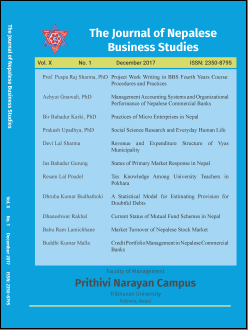A Statistical Model for Estimating Provision for Doubtful Debts
DOI:
https://doi.org/10.3126/jnbs.v10i1.19135Keywords:
Conditional probabilities, Iteration, Markov chain, Realisation, Steady state, Stochastic process, Transition matrix.Abstract
This paper attempts to analyze a statistical model for estimating provision for doubtful debts based on available data and literature. Where a significant portion of an enterprise’s assets are tied up in Sundry Debtors (of any kind), the accuracy achieved in estimating this provision for doubtful debts assumes a special significance. This is very much well known to anyone who is seriously connected with financial matters, whether under any statute or for carrying out management accounting exercise. However, this paper is not intended to over-emphasize this aspect of financial management accounting. The purpose of this paper is to attempt to build a statistical model to enhance the degree of accuracy in this regard. The customary practice prevalent, at least in Nepal, is to estimate it mainly by applying a highly subjective judgmental process, bordering on a hunch-oriented process.
The Journal of Nepalese Business Studies Vol. X No. 1 December 2017, Page: 78-84
Downloads
Downloads
Published
How to Cite
Issue
Section
License
This license allows reusers to distribute, remix, adapt, and build upon the material in any medium or format, so long as attribution is given to the creator. The license allows for commercial use.




